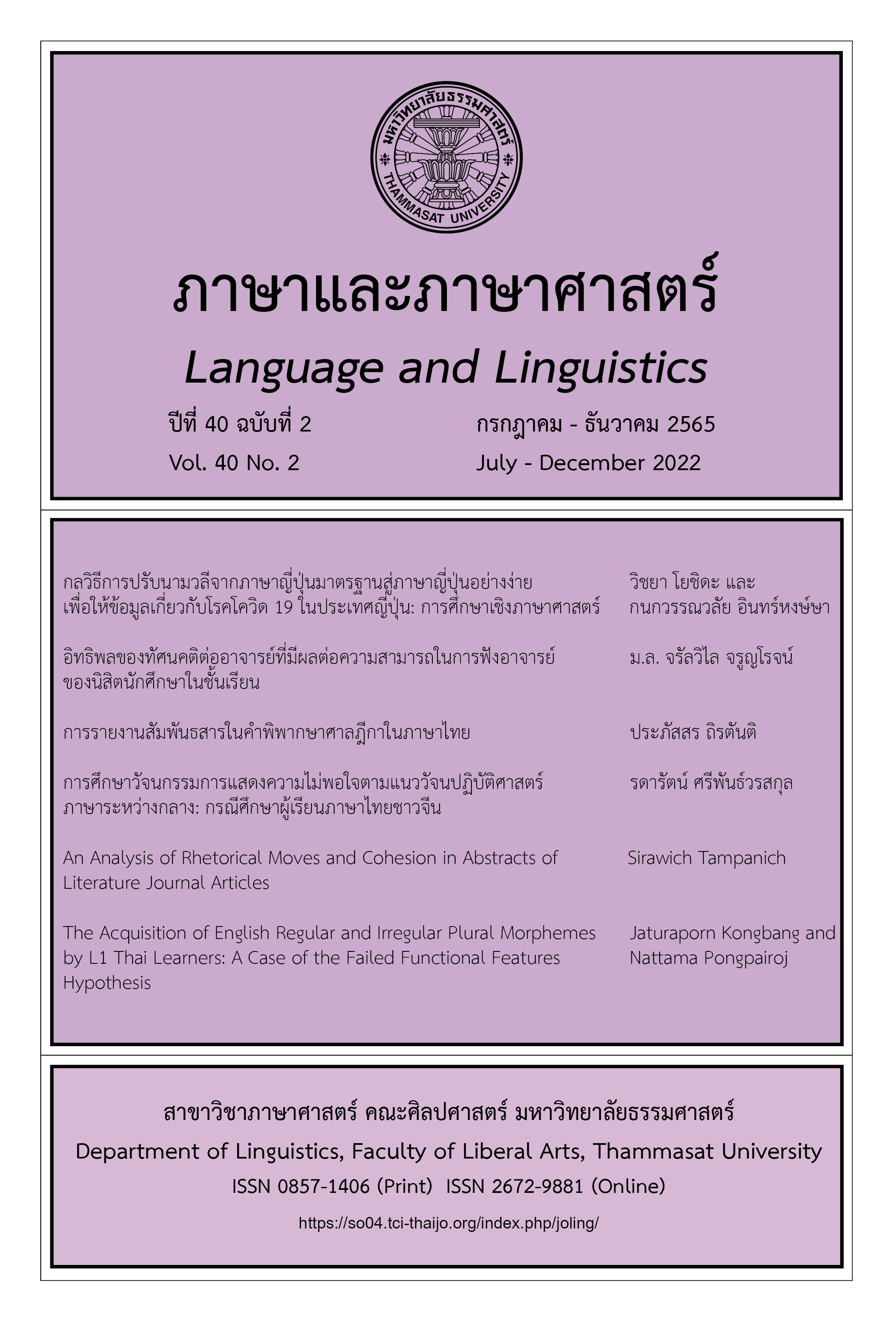The Discourse Presentation in Supreme Court Judgments in Thai
Main Article Content
Abstract
Although a Supreme Court judgment is a decision from the highest court in Thailand’s justice system, it does not merely describe judicial decision-making. It is rich in spoken and written discourse that is recorded and transcribed during judicial proceedings. This article aims to describe the characteristics of discourse presentations in Thai Supreme Court judgments and compare the language used in these judgments to features of the Thai legal register. The results show that the language used to refer to the original speakers/authors of the discourse presentations and to present reported utterances pattern in various ways. While there are some characteristics that share linguistic attributes with the Thai legal register, such as the complexity of sentence structures and jargon used, there are some unique features that are particularly noteworthy in the findings such as the use of personal pronouns and subjective language.
Article Details

This work is licensed under a Creative Commons Attribution-NonCommercial-NoDerivatives 4.0 International License.
บทความทุกบทความเป็นลิขสิทธิ์ของภาษาและภาษาศาสตร์
References
ชาคริต อนันทราวัน. (2548). การใช้ภาษานักกฎหมาย (ตำรวจ อัยการ ทนายความ ผู้พิพากษา). สำนักพิมพ์แห่งจุฬาลงกรณ์มหาวิทยาลัย.
ณัฐพร พานโพธิ์ทอง. (2556). วาทกรรมวิเคราะห์เชิงวิพากษ์ตามแนวภาษาศาสตร์: แนวคิดและการนำมาศึกษาวาทกรรมในภาษาไทย. โครงการเผยแพร่ผลงานวิชาการ คณะอักษรศาสตร์ จุฬาลงกรณ์มหาวิทยาลัย.
ดุลยการณ์ กรณฑ์แสง. (2537). การวิเคราะห์การนิยามคำศัพท์ภาษากฎหมาย: กฎหมายมรดกและครอบครัว [วิทยานิพนธ์ปริญญามหาบัณฑิต]. มหาวิทยาลัยธรรมศาสตร์.
ธานินทร์ กรัยวิเชียร และ วิชา มหาคุณ. (2523). การตีความกฎหมาย. คณะนิติศาสตร์ จุฬาลงกรณ์มหาวิทยาลัย.
เธียร เจริญวัฒนา. (2554). ข้อสังเกตในการเรียงคำพิพากษา. ใน ศาลอุทธรณ์และสำนักงานศาลยุติธรรม, สำนวนโวหารในการเรียงคำพิพากษาและเหตุผลในการวินิจฉัยคดี (หน้า 19-20). ศาลอุทธรณ์และสำนักงานศาลยุติธรรม.
นัทธ์ชนัน นาถประทาน. (2555). การเว้นระยะห่างจากผู้ฟังหรือผู้อ่านในภาษากฎหมาย ภาษาการเมือง ภาษาสื่อ และภาษาวิชาการของไทย. วารสารมนุษยศาสตร์, 19(2), 1-23.
พิมพา จิตตประสาทศีล. (2548). การศึกษาลักษณะภาษากฎหมายในภาษาไทย: ประมวลกฎหมายอาญาและประมวลกฎหมายแพ่งและพาณิชย์ [วิทยานิพนธ์ปริญญามหาบัณฑิต]. มหาวิทยาลัยธรรมศาสตร์.
รัชนีย์ญา กลิ่นน้ำหอม. (2546). การศึกษาวิเคราะห์ภาษาในประมวลกฎหมายอาญา [วิทยานิพนธ์ปริญญามหาบัณฑิต]. มหาวิทยาลัยศรีนครินทรวิโรฒ.
วรรณวนัช อรุณฤกษ์. (2559). ลักษณะภาษา รูปแบบ และเนื้อหาในคำพิพากษาของศาลทหารสูงสุด [วิทยานิพนธ์ปริญญามหาบัณฑิต] มหาวิทยาลัยธรรมศาสตร์.
ศาลฎีกา. (2561). คำพิพากษาศาลฎีกา พุทธศักราช ๒๕๖๑. สำนักอำนวยการประจำศาลฎีกา.
สรบุศย์ รุ่งโรจน์สุวรรณ, นัทธ์ชนัน นาถประทาน, และ อมรา ประสิทธิ์รัฐสินธุ์. (2558). ภาษาแห่งอำนาจ: การวิเคราะห์วัจนลีลาของภาษากฎหมาย ภาษา การเมือง ภาษาสื่อ และภาษาวิชาการของสังคมไทย: การวิเคราะห์วัจนลีลาภาษากฎหมายไทย. สำนักงานคณะกรรมการส่งเสริมวิทยาศาสตร์ วิจัยและนวัตกรรม.
สุธาสินี ปิยพสุนทรา. (2556). ประโยครวมและประโยคซ้อนในทำเนียบภาษาวิชาการ ภาษาการเมือง ภาษากฎหมาย และภาษาสื่อ. วรรณวิทัศน์, 13(1), 115-139.
อนงค์นาฏ นุศาสตร์เลิศ. (2556). การใช้คำเรียกขานในภาษาการเมือง กฎหมาย ภาษาสื่อ และภาษาวิชาการของไทย. มนุษยศาสตร์สังคมศาสตร์, 30(3), 117-130.
Bakhtin, M. M. (1981). The dialogic imagination: Four essays by M. M. Bakhtin. (M. Holquist, Ed., C. Emerson, & M. Holquist, Trans.). University of Texas Press.
Bhatia, V. (1987). Language of the law. Language Teaching, 20(4), 227-234.
Biber, D., & Conrad, S. (2009). Register, genre and style. Cambridge University Press.
Clark, H. H., & Gerrig, R. J. (1990). Quotations as demonstrations. Language, 66(4), 784-805.
Coulmas, F. (1986). Direct and indirect speech. Mouton de Gruyter.
Fairclough, N. (1992). Discourse and social change. Polity Press.
Fludernik, M. (1993). The fictions of language and the languages of fiction. Routledge.
Greenawalt, K. (1992). Law and objectivity. Oxford University Press.
Hames, J. B., & Ekern, Y. (2006). Introduction to law (3rd ed.). Pearson.
Leech, G., & Short, M. (1981). Style in fiction: A linguistic introduction to English fictional prose. Pearson Longman.
Mahoney, D. (2003). Judgment writing: Form and function. In R. Sheard (Ed.), A matter of judgment: Judical decision-making and judgment writing (pp. 103-116). Ligare Book Printer.
McIntyre, D., & Walker, B. (2011). Discourse presentation in early modern English writing: A preliminary corpus-based investigation. International Journal of Corpus Linguistics, 16(1), 101-130.
Redeker, G. (1996). Free indirect discourse in newspaper reports. In C. Cremers & M. den Dikken (Eds.), Linguistics in the Netherlands 1996 (pp. 221-232). John Benjamins.
Semino, E., & Short, M. (2004). Corpus stylistics: Speech, writing and thought presentation in a corpus of English writing. Routledge.
Short, M. (2012). Discourse presentation and speech (and writing, but not thought) summary. Language and Literature, 21(1), 18-32.
Thompson, G. (1996). Voices in the text: Discourse perspectives on language reports. Applied Linguistics, 17(4), 501-530.
Tiersma, P. (1999). Legal language. University of Chicago Press.
Tiersma, P. (2008). The nature of legal language. In J. Gibbons & T. M. Teresa (Eds.), Dimensions of forensic linguistics (pp. 7-26). John Benjamins.
Wiebe, J., Wilson, T., Bruce, R., Bell, M., & Martin, M. (2004). Learning subjective language. Computational Linguistics, 30(3), 277-308.


